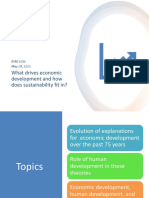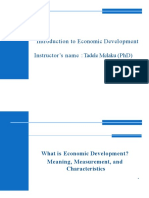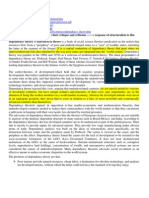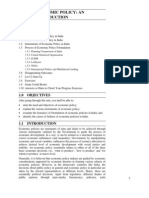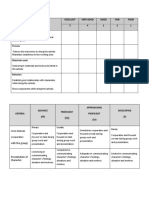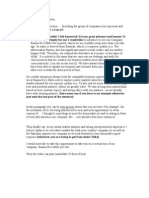0 ratings0% found this document useful (0 votes)
277 viewsEconomic Growth Refers To An Increase in The Capacity
Economic Growth Refers To An Increase in The Capacity
Uploaded by
Dora NasikeEconomic growth refers to an increase in a country's capacity to produce goods and services over time. It involves shifting the production possibility frontier outward, allowing more goods and services to be produced. Economic growth is driven by factors like technological progress, increases in capital and labor, and improvements in human capital. There are also costs and limitations to economic growth, such as resource depletion, pollution, and worsening income inequality.
Copyright:
Attribution Non-Commercial (BY-NC)
Available Formats
Download as PPT, PDF, TXT or read online from Scribd
Economic Growth Refers To An Increase in The Capacity
Economic Growth Refers To An Increase in The Capacity
Uploaded by
Dora Nasike0 ratings0% found this document useful (0 votes)
277 views24 pagesEconomic growth refers to an increase in a country's capacity to produce goods and services over time. It involves shifting the production possibility frontier outward, allowing more goods and services to be produced. Economic growth is driven by factors like technological progress, increases in capital and labor, and improvements in human capital. There are also costs and limitations to economic growth, such as resource depletion, pollution, and worsening income inequality.
Original Title
Week 2-Economic Growth
Copyright
© Attribution Non-Commercial (BY-NC)
Available Formats
PPT, PDF, TXT or read online from Scribd
Share this document
Did you find this document useful?
Is this content inappropriate?
Economic growth refers to an increase in a country's capacity to produce goods and services over time. It involves shifting the production possibility frontier outward, allowing more goods and services to be produced. Economic growth is driven by factors like technological progress, increases in capital and labor, and improvements in human capital. There are also costs and limitations to economic growth, such as resource depletion, pollution, and worsening income inequality.
Copyright:
Attribution Non-Commercial (BY-NC)
Available Formats
Download as PPT, PDF, TXT or read online from Scribd
Download as ppt, pdf, or txt
0 ratings0% found this document useful (0 votes)
277 views24 pagesEconomic Growth Refers To An Increase in The Capacity
Economic Growth Refers To An Increase in The Capacity
Uploaded by
Dora NasikeEconomic growth refers to an increase in a country's capacity to produce goods and services over time. It involves shifting the production possibility frontier outward, allowing more goods and services to be produced. Economic growth is driven by factors like technological progress, increases in capital and labor, and improvements in human capital. There are also costs and limitations to economic growth, such as resource depletion, pollution, and worsening income inequality.
Copyright:
Attribution Non-Commercial (BY-NC)
Available Formats
Download as PPT, PDF, TXT or read online from Scribd
Download as ppt, pdf, or txt
You are on page 1of 24
ECONOMIC GROWTH
Economic growth; refers to an increase in the capacity
of the economy to produce goods and services over
time.
Economic growth is the single most powerful engine for
generating long-term increases in standards of living
than the removal of recessionary gaps, unemployment,
or inefficiencies because growth can go indefinitely.
In economic theory terms, it involves a shifting
outwards of the production possibility frontier,
showing that the economy as a whole can produce
more goods and services than it could previously.
WHAT CAUSES THE CURVE TO SHIFT
1. Technology can increase the economy’s
production capabilities.
2. Improvements in and greater stocks of
land, labor, and capital can shift out the
production possibilities curve.
3. Another way of saying that economic
growth has shifted the production
possibilities curve out is to say that
growth has increased potential output.
TYPES OF ECONOMIC GROWTH
Real Economic Growth; is the increase in real
GDP as a result of using previously
unemployed resources, re-allocating existing
resources to more productive sectors or using
new or improved resources.
Potential Economic Growth; is the increase in
the productive capacity of the economy thus in
the ability of the economy to produce goods.
This occurs as a result of an increase in the
quality and quantity of resources.
DETERMINANTS OF ECONOMIC GROWTH
• Re-allocate resources from low productivity
to high productivity activities/sectors- for
instance from defence to health care
• Growth in the labour force- growth in the
population or participation rates in proportion to the
total population.
• Investment in human capital- HC is the
knowledge and skill embodied in people including
formal education and on-the-job training. It involves
improvement of health and longevity of the population,
technical training depending on the current knowledge
and literacy rates and contribution to growth and
innovation..
• Technological changes- these are brought by
innovations that introduce new products and new ways
of producing existing products. Technological progress
can be divided into; capital saving technology, labour
saving technology and neutral technical advance.
• Investment in physical capital- such as
factories, machines, transportation and communication
facilities.
• It must be government policy – government
must formulate policies aimed at promoting
efficient and effective use of the available
natural resources for economic growth to occur.
COURSE WORK 1
1 (a) What is Economic growth? Examine the
factors for economic growth.
(b) Critically examine Rostow’s stages of
Economic growth citing the criticisms/
limitations at each stage.
Due date: Wednesday 15th June 2011
NB: (Font- Verdana, font size – 12, spacing – 1.5, not less
than 5 pages + an extra page for references)
THE BENEFITS OF GROWTH
Increased levels of consumption; Provided economic
growth outstrips population growth, it will lead to
higher real income per head. This can lead to higher
levels of consumption of goods and services. If human
welfare is related to the level of consumption, then
growth provides an obvious gain to society.
It can help avoid other macroeconomic problems;
People have aspirations of rising living standards.
Without a growth in productive potential, people’s
demands for rising incomes are likely to lead to higher
inflation, balance of payments crises (as more imports
are purchased), industrial disputes, etc. Growth in
productive potential helps to meet these aspirations
and avoid macroeconomic crises.
It can make it easier to redistribute incomes to the
poor; If incomes rise, the government can redistribute
incomes from the rich to the poor without the rich
losing. For example, as people’s incomes rise, they
automatically pay more taxes. These extra revenues for
the government can be spent on programmes to
alleviate poverty. Without a continuing rise in national
income the scope for helping the poor is much more
limited.
Society may feel that it can afford to care more for
the environment; As people grow richer, they may
become less preoccupied with their own private
consumption and more concerned to live in a clean
environment. The regulation of pollution tends to be
tougher in developed countries than in the developing
world.
THE COSTS OF GROWTH
In practice, more consumption may not make people happier; economies
may be no less crisis riden; incomes may not be redistributed more
equally; the environment may not be better protected. More than this,
some people argue that growth may worsen these problems and create
additional problems besides. Some of the costs include;
The current opportunity cost of growth; To achieve faster growth,
firms will probably need to invest more. This will require financing.
The finance can come from a higher saving rate or higher taxes.
Either way, there must be a cut in consumption. In the short run,
therefore, higher growth leads to less consumption, not more.
Growth may simply generate extra demands; ‘The more people
have, the more they want.’ If this is so, more consumption may not
increase people’s happiness at all. (It is often observed that rich
people tend to be miserable!)
social effects; Many people claim that an excessive
pursuit of material growth by a country can lead to a
more greedy, more selfish and less caring society. As
society becomes more industrialised, violence, crime,
loneliness, stress-related diseases, suicides, divorce
and other social problems are likely to rise.
Environmental costs; A richer society may be more
concerned for the environment, but it is also likely to
do more damage to it. The higher the level of
consumption, the higher is likely to be the level of
pollution and waste. What is more, many of the
environmental costs are likely to be underestimated
due to a lack of scientific knowledge. Acid rain and the
depletion of the ozone layer have been two examples.
Non-renewable resources; If growth involves using a greater
amount of resources, rather than using the same amount of
resources more efficiently, certain non-renewable resources
will run out more rapidly. Unless viable alternatives can be
found for various minerals and fossil fuels, present growth
may lead to shortages for future generations.
Effects on the distribution of income; While some people
may gain from a higher standard of living, others are likely
to lose. If the means to higher growth are greater incentives
(such as cuts in higher rates of income tax), then the rich
might get richer, with little or no benefits ‘trickling down’ to
the poor. Growth involves changes in production: both in
terms of the goods produced and in terms of the techniques
used and the skills required. The more rapid the rate of
growth, the more rapid the rate of change. People may find
that their skills are no longer relevant. Their jobs may be
replaced by machines. People may thus find themselves
unemployed, or forced to take low-paid, unskilled work.
LIMITATIONS OF GROWTH
1. Resource exhaustion
2. Renewable resources
3. Pollution
4. Conflicts between many policies of
government
5. External trade influences through
improvements and deteriorations in the
terms of trade.
PROBLEMS OF GROWTH IN LDCs
1. Low per capita income
2. Poverty –reduces quality to save
3. Inefficient allocation of resources
4. Increasing rate of population growth
5. Lo quality land and labour
6. Abundant and untrained population
7. Lack of entrepreneur enterprise
8. Evasion of taxes
9. A tropical climate
10.Inefficient banking system- failure to mobilise
savings
11.Wide spread under employment
PRIVATE STUDY
1. Chenery’s patterns of Development(the ten
basic development processes that describe
the dimensions of structural transformation
of LDCs.)
• Chenery and colleagues examined patterns of
development for developing countries at different
percapita income levels during the post-war period.
• Major hypothesis is that development is an
identifiable process of growth and change whose main
features are similar in all countries.
• The empirical studies identified several characteristic
features of economic development:
– Shift from agriculture to industrial production
– Steady accumulation of physical and human
capital
– Change in consumer demands
– Increased urbanization
– Decline in family size
– Demographic transition
MEANING AND CHARACTERISTICS OF
MODERN ECONOMIC GROWTH (MEG)
Modern Economic Growth (MEG) is the term applied by
Simon Kuznets to describe the economic epoch of the
last 250 years, distinguished by the pervasive
application of science-based technology to production.
Professor Simon Kuznets defines MEG as; a long-term
rise in capacity to supply increasingly diverse
economic goods to its population, this growing
capacity based on advancing technology and the
institutional and ideological adjustments that it
demands.
MEG simply refers to the development of the developed
countries of Western Europe, the USA, Canada,
Australia, China, Korea, Hong Kong and Japan among
others.
COMPONENTS OF MODERN
ECONOMIC GROWTH
This definition brings forth 3 components
1.That Economic Growth is identified by the
sustained increase in the supply of goods
2.That advancing technology is the permissive
factor in Economic Growth which determines
the growth of capacity in supplying a diverse
range of good to the population.
3.That for an efficient and wide use of technology
and its development, institutional and
ideological adjustments must be made to effect
the proper use of innovations generated by
advancing stock of human knowledge.
CHARACTERISTICS OF MODERN
ECONOMIC GROWTH
There are 6 characteristics identified by Prof. Kuznets.
2 of which are Quantitative (relating to national output
and population)
• High rates of growth of per capita and population
• The rise in productivity
2 relate to Structural transformation
• High rate of structural transformation
• Urbanisation
2 relate to the International spread
• The outward expansion of developed countries
• International flows of men, goods and capital
High rates of growth per capita product and population;
modern growth is characterised by high rates of increase
in per capita product accompanied by substantial rates of
population growth. That MEG meant a striking
accelerated rise not only in product per capita but also in
population does not imply that the latter was a necessary
condition fro the former. In some countries, high rates of
growth in per capita product were accompanied by high
rates of population increase and in other low rates.
The rise in productivity; MEG is characterised by a rise in
the rate per capita product due to improvements in the
quality of inputs which has led to greater efficiency or rise
in the productivity per unit. Increase in efficiency implies
greater output per unit of input. According to Kuznets we
find that the rate of increase in productivity is large
enough to account for almost the entire growth of product
per capita in the developed countries.
High rate of structural transformation; structural
transformations in MEG include, a shift away from
agriculture to non agricultural activities an from
industry to services, an increase in scale of productive
units, shifts in organization (personal enterprises -
impersonal) and a corresponding change in the
occupational the status of labor, shifts in the structure
of consumption among others. These intersectoral shifts
were accompanied by growth in the sacla of firma and
changes in the type of organisation within sectors such
as manufacturing or trade from incorporated firms to
the large corporate units with rapid shifts in industrial
structure and rapid changes in technology. There were
also rapid shifts in the allocation of products among
types and sizes of producing firms and consequently in
the allocation of the labour force from blue-white collar
jobs, from less to more skilled occupations and from
small to large organs
Urbanisation ; MEG is characterised by the movement of an
increasing proportion of the population in developed countries
from rural to urban areas. This is largely a product of
industrialisation. However the changes in conditions of life
suggested by "urbanization" clearly involves a variety of costs and
returns that are not now included in economic measurement.
Internal migration, from the countryside to the cities represents
substantial costs in the pulling up of roots and the adjustment to
the anonymity and higher costs of urban living. According to
Kuznets, urbanisation affects the consumer expenditure in 3
ways:
1. Urbanisation led to an increasing division of labour, growing
specialisation, and a shift of many activities from non market
oriented to specialised market oriented firms.
2. It made the satisfaction of an increasing number of wants more
costly i.e. urban life became costlier because of congestion and
overcrowding.
3. The demonstration effect of the city life led to imitation of
consumption patterns by the large immigrants which led to
increased consumer expenditure.
The outward expansion of developed countries; the
economically developed countries, by means of the
increased power of technology, particularly in transport
and communication (both peaceful and warlike), have the
propensity to reach out to the rest of the world - thus
making for one world. Growth of developed countries has
been uneven i.e. it occurred in some nations earlier than
it did in others. This was largely due to the differences in
Historical background for instance the industrial
revolution first occurred in England the later spread to
other countries in Europe. The outward expansion of
developed countries with their European origin has bee
primarily due to the technological revolution in
transportation and communication. This led to more
direct dominance over colonies, the opening up of
previously closed areas like Japan and the partition of
undivided areas like sub Saharan Africa.
International flows of men, goods and
capital; the international flows of men,
goods and capital increased from the 2nd
quarter of the 19th century. It was
charaterised by migration (international
migrations), flows of goods and flows of
capital across the world. It also involved
extended application of science to
problems of economic production and
Politics.
You might also like
- Albert MehrabianDocument4 pagesAlbert Mehrabiansarah284035No ratings yet
- Lecture 1 Chapter 1 TodaroDocument24 pagesLecture 1 Chapter 1 TodaroKhadeeza ShammeeNo ratings yet
- Theories of DevelopmentDocument35 pagesTheories of DevelopmentD Attitude Kid94% (18)
- An Introduction To CRMDocument48 pagesAn Introduction To CRMDora Nasike100% (2)
- Methods of Teaching Science in The Elementary GradeDocument22 pagesMethods of Teaching Science in The Elementary GradeRUTHY ANN BALBIN BEEd 2-1100% (2)
- Church of AbadarDocument4 pagesChurch of AbadarCourtneyNo ratings yet
- Economics QuestionsDocument4 pagesEconomics QuestionsSyed Atiq Turabi100% (1)
- 2018 - CDEV011 - All - Slides - Final 2Document226 pages2018 - CDEV011 - All - Slides - Final 2ZachariaNo ratings yet
- Chapter 11 HANDOUTSDocument6 pagesChapter 11 HANDOUTSHazell DNo ratings yet
- Measurement of Economic DevelopmentDocument10 pagesMeasurement of Economic DevelopmentFaisal ShafiqueNo ratings yet
- Part One: Principles and ConceptsDocument11 pagesPart One: Principles and ConceptsGoviNo ratings yet
- Relevance of Keynesian Theory To The Current EconomicDocument15 pagesRelevance of Keynesian Theory To The Current EconomicSiva Krishna Reddy NallamilliNo ratings yet
- Chapter 3...Document10 pagesChapter 3...hakseng lyNo ratings yet
- Chapter-3 Meade's ModelDocument16 pagesChapter-3 Meade's ModelDenaw AgimasNo ratings yet
- Economics of Development: Professor Sisay AsefaDocument24 pagesEconomics of Development: Professor Sisay AsefadavedullNo ratings yet
- Notes On Development EconomicsDocument9 pagesNotes On Development EconomicsDon Zian EncarnacionNo ratings yet
- Assignment - Chapter 6 (Strategies For Economic Development)Document5 pagesAssignment - Chapter 6 (Strategies For Economic Development)akshaylt25100% (1)
- Effect of Population Growth Rate On Economic DevelopmentDocument10 pagesEffect of Population Growth Rate On Economic DevelopmentyashbhardwajNo ratings yet
- Economic Development A Global Perspective Chapter 1Document47 pagesEconomic Development A Global Perspective Chapter 1Meriel Stephanie Zaragoza100% (1)
- Theories of Economic Development 2023Document16 pagesTheories of Economic Development 2023anushikha banerjeeNo ratings yet
- Ch1-4 AdvancedDecEco PDFDocument223 pagesCh1-4 AdvancedDecEco PDFUrgessa FiromsaNo ratings yet
- Fiscal PolicyDocument16 pagesFiscal PolicyMar DacNo ratings yet
- Migration in The Caribbean-Dr Karoline SchmidtDocument11 pagesMigration in The Caribbean-Dr Karoline SchmidtALNPhNo ratings yet
- Chapter 1 Introducing Economic DevelopmentDocument17 pagesChapter 1 Introducing Economic DevelopmentRuthchell Ciriaco100% (1)
- Assignments For Development Economics IDocument1 pageAssignments For Development Economics IMahinur MimiNo ratings yet
- Chapter 1 Introduction To Economic DevelopmentDocument32 pagesChapter 1 Introduction To Economic DevelopmentHoney Faith Dela Cruz100% (1)
- Lecture6&7Human Poverty IndexDocument41 pagesLecture6&7Human Poverty IndexcraftyNo ratings yet
- Development Economics Unit 1 and 2Document64 pagesDevelopment Economics Unit 1 and 2ibsa100% (1)
- What Is Income Inequality?Document8 pagesWhat Is Income Inequality?shikharohraNo ratings yet
- Introduction To Economics: (A) What Economics Is All About ?Document16 pagesIntroduction To Economics: (A) What Economics Is All About ?Smriti JoshiNo ratings yet
- Devlopment and DependencyDocument7 pagesDevlopment and Dependencygangadhar119No ratings yet
- Development Economics - Chapter 6Document8 pagesDevelopment Economics - Chapter 6Joshua Miguel Bartolata100% (1)
- Economic IndicatorsDocument10 pagesEconomic Indicatorss.r.100% (1)
- ECS3707 Development Economic NotesDocument23 pagesECS3707 Development Economic NotesLesego Geraldine KgoeleNo ratings yet
- Unit 1 Economic Policy: An: 1.0 ObjectivesDocument12 pagesUnit 1 Economic Policy: An: 1.0 Objectivesdineshdesai123No ratings yet
- Development Economics Chapter 3Document11 pagesDevelopment Economics Chapter 3JENISH NEUPANENo ratings yet
- Poverty 1Document148 pagesPoverty 1daudimtui1889No ratings yet
- Basic Concept of Macro Economics: Unit 1Document31 pagesBasic Concept of Macro Economics: Unit 1Roxanne OsalboNo ratings yet
- Lecture On 7d and CCD ApproachDocument20 pagesLecture On 7d and CCD ApproachMohsin KhanNo ratings yet
- Why Do Economic Problems AriseDocument11 pagesWhy Do Economic Problems Arisemrrakeshkumar810No ratings yet
- Welfare EconomicsDocument6 pagesWelfare EconomicsAsawari SavarikarNo ratings yet
- Chapter 1 SummaryDocument7 pagesChapter 1 SummaryArbie MoralesNo ratings yet
- 4 Major Sectors of An Economy: 1. Household SectorDocument3 pages4 Major Sectors of An Economy: 1. Household SectorMartha EeluNo ratings yet
- Kotebe Metropolitain University College of Business and EconomicsDocument50 pagesKotebe Metropolitain University College of Business and Economicsበላይ የሸበል በረንታውNo ratings yet
- Chapter-One Overview of Public Finance & TaxationDocument211 pagesChapter-One Overview of Public Finance & Taxationarsen lupinNo ratings yet
- Macroeconomic Policy Objectives Lesson 2Document12 pagesMacroeconomic Policy Objectives Lesson 2api-53255207No ratings yet
- Business EconomicsDocument25 pagesBusiness EconomicsNARYAN SharmaNo ratings yet
- Theory of Scientific ManagementDocument8 pagesTheory of Scientific ManagementAmba Datt PantNo ratings yet
- EconomicsDocument14 pagesEconomicsRaúl AshokNo ratings yet
- Eco - Ed. 429 Economics of Dev & Plan Including Added MattersDocument6 pagesEco - Ed. 429 Economics of Dev & Plan Including Added MattersHari PrasadNo ratings yet
- Economic Growth and DevelopmentDocument39 pagesEconomic Growth and DevelopmentSmileCaturasNo ratings yet
- Consumption and SavingsDocument6 pagesConsumption and SavingsIvan Jovans LUTTAMAGUZINo ratings yet
- The Challenges of Public Policy Formulation and Evaluation Through The Questions "What, Who, How, and When?Document12 pagesThe Challenges of Public Policy Formulation and Evaluation Through The Questions "What, Who, How, and When?sNo ratings yet
- Project in EconomicsDocument47 pagesProject in EconomicsKishoreAgarwalNo ratings yet
- Economic Development Reviewer - Chapter 3 - Todaro and SmithDocument6 pagesEconomic Development Reviewer - Chapter 3 - Todaro and SmithjulyettemorotadanaoNo ratings yet
- Economic Development Syllabus 2018Document5 pagesEconomic Development Syllabus 2018Mohammad Khaerul AzisNo ratings yet
- Eco - Ed. 428 Nepalese EconomyDocument7 pagesEco - Ed. 428 Nepalese EconomyHari PrasadNo ratings yet
- ECON 3066 Economic Developm EntDocument48 pagesECON 3066 Economic Developm Entdipalsd100% (1)
- Chapter 1 Part 1Document4 pagesChapter 1 Part 1Jecel FranciscoNo ratings yet
- Short Notes On Public FinanceDocument3 pagesShort Notes On Public FinanceJakir_bnkNo ratings yet
- Economics of Welfare Lecture NotesDocument54 pagesEconomics of Welfare Lecture NotesAbhi Bhardwaj100% (1)
- Asia’s Fiscal Challenge: Financing the Social Protection Agenda of the Sustainable Development GoalsFrom EverandAsia’s Fiscal Challenge: Financing the Social Protection Agenda of the Sustainable Development GoalsNo ratings yet
- A & MKTG SampleDocument1 pageA & MKTG SampleDora NasikeNo ratings yet
- CRM ToolsDocument21 pagesCRM ToolsDora NasikeNo ratings yet
- Msic - Organisational CultureDocument9 pagesMsic - Organisational CultureDora NasikeNo ratings yet
- Advertising IntroDocument62 pagesAdvertising IntroDora NasikeNo ratings yet
- CONSUMER Personality & LifestyleDocument79 pagesCONSUMER Personality & LifestyleDora NasikeNo ratings yet
- Factors Influencing Buyer BehaviorDocument21 pagesFactors Influencing Buyer BehaviorDora NasikeNo ratings yet
- Ibr - Ethics and International BusinessDocument34 pagesIbr - Ethics and International BusinessDora NasikeNo ratings yet
- Advertising and Brand ManagementDocument2 pagesAdvertising and Brand ManagementDora NasikeNo ratings yet
- Week 3Document16 pagesWeek 3Dora NasikeNo ratings yet
- 1 Networking Your BusinessDocument10 pages1 Networking Your BusinessDora NasikeNo ratings yet
- Chapter 7 Product MixDocument12 pagesChapter 7 Product MixDora NasikeNo ratings yet
- Ca 1 - Institutional Corrections: History of Correction, The Nature and Trends of PunishmentDocument52 pagesCa 1 - Institutional Corrections: History of Correction, The Nature and Trends of PunishmentJayson ampatuan100% (1)
- Criteria Excellent 5 Very Good 4 Good 3 Fair 2 Poor 1 Composition and DesignDocument2 pagesCriteria Excellent 5 Very Good 4 Good 3 Fair 2 Poor 1 Composition and DesignFarrah MacalinoNo ratings yet
- Human Resources: Standard Operating ProcedureDocument11 pagesHuman Resources: Standard Operating ProcedureSreekanth SNo ratings yet
- Lectures On The Legal System of The USDocument556 pagesLectures On The Legal System of The USlocusstandi84No ratings yet
- ARTS1211 2018 Essay Briefing Paper TopicsDocument1 pageARTS1211 2018 Essay Briefing Paper TopicsJacky WangNo ratings yet
- Bridge Design, Construction and Maintenance Course 2019 - Dubai, Cape Town, LondonDocument5 pagesBridge Design, Construction and Maintenance Course 2019 - Dubai, Cape Town, LondonprofessionNo ratings yet
- Basma Rice Mills PVTDocument3 pagesBasma Rice Mills PVTAmna SaadatNo ratings yet
- A Closer Look at Attention To DetailDocument6 pagesA Closer Look at Attention To DetailUmair SaeedNo ratings yet
- Peter Sims Little BetsDocument3 pagesPeter Sims Little BetsShreya PurkaitNo ratings yet
- Project Outline MSL501 2021Document7 pagesProject Outline MSL501 2021Ahmed AwaisNo ratings yet
- Air Ticket Del - MumDocument2 pagesAir Ticket Del - MumAmitNo ratings yet
- Trading and Settlement in Dematerialised SecuritiesDocument1 pageTrading and Settlement in Dematerialised SecuritiesKhushiNo ratings yet
- Skill - Samsodisha.gov - in ManageStudent DiplomaCafPrint - Aspx Enc Vs VwIeMYdyG YRR3293GaII0S07lXxOKPxbCoRqozBpMN+Kly90+pNAcE VFZWN PDFDocument2 pagesSkill - Samsodisha.gov - in ManageStudent DiplomaCafPrint - Aspx Enc Vs VwIeMYdyG YRR3293GaII0S07lXxOKPxbCoRqozBpMN+Kly90+pNAcE VFZWN PDFDibyadarshan SahooNo ratings yet
- All India Institute of Speech & Hearing: Mysuru - 6: WWW - Aiishmysore.inDocument7 pagesAll India Institute of Speech & Hearing: Mysuru - 6: WWW - Aiishmysore.inPawan KshatriyaNo ratings yet
- ECG BrochureDocument2 pagesECG BrochureMaria Rowena O. SalvoNo ratings yet
- A New Approach For Curbing College Tuition InflationDocument16 pagesA New Approach For Curbing College Tuition InflationManhattan InstituteNo ratings yet
- Postgraduate Diploma in Media Management (PDMM) : ModulesDocument2 pagesPostgraduate Diploma in Media Management (PDMM) : ModulesLife NoanneNo ratings yet
- EmpowermentDocument78 pagesEmpowermentAna Marie Guevarra100% (1)
- Hildegard EDocument10 pagesHildegard EHazel LezahNo ratings yet
- Robotpilóta Rendszerek: Budapesti Műszaki EgyetemDocument78 pagesRobotpilóta Rendszerek: Budapesti Műszaki EgyetemNaguibNo ratings yet
- LAKMEDocument26 pagesLAKMESejal_Sheth_945167% (3)
- Unique Identity Card For The Disabled (UDID) - Application - IndiaFilings PDFDocument12 pagesUnique Identity Card For The Disabled (UDID) - Application - IndiaFilings PDFsunil GupteNo ratings yet
- The Heart of A Teacher - Identity andDocument8 pagesThe Heart of A Teacher - Identity andvideos UNo ratings yet
- LT 5th Grade RecordersDocument4 pagesLT 5th Grade Recordersapi-453445899No ratings yet
- Criteria For Type A Type B and Type C Inspection BodiesDocument11 pagesCriteria For Type A Type B and Type C Inspection BodiesmirraoNo ratings yet
- Engineering Book: FIRST Global Challenge 2019Document3 pagesEngineering Book: FIRST Global Challenge 2019Gregory RamirezNo ratings yet
- 7 - Table - Anna University 2020 Apr-May Exam Time TableDocument2 pages7 - Table - Anna University 2020 Apr-May Exam Time TableSundar Shankar NarayananNo ratings yet





















